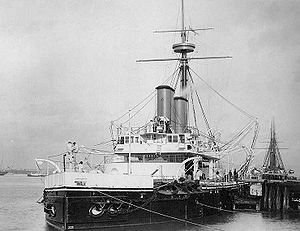HMS Dreadnought (1875)

Bow view of Dreadnought, probably after 1894
|
|
| Class overview | |
|---|---|
| Operators: |
|
| Preceded by: | Devastation class |
| Succeeded by: | HMS Neptune |
| Completed: | 1 |
| Scrapped: | 1 |
| History | |
|
|
|
| Name: | Dreadnought |
| Ordered: | 1870 Naval Programme |
| Builder: | Pembroke Dockyard |
| Way number: | No. 2 |
| Laid down: | 10 September 1870 |
| Launched: | 8 March 1875 |
| Completed: | 15 February 1879 |
| Commissioned: | 1884 |
| Out of service: | 1905 |
| Reclassified: | As second-class battleship, 1900 |
| Fate: | Sold for scrap, 14 July 1908 |
| General characteristics (as built) | |
| Type: | Ironclad turret ship |
| Displacement: | 10,886 long tons (11,061 t) |
| Length: | 320 ft (97.5 m) (pp) *343 ft (105 m) (oa) |
| Beam: | 63 ft 10 in (19.5 m) |
| Draught: | 26 ft 6 in (8.1 m) |
| Installed power: | 8,206 ihp (6,119 kW); 12 cylindrical boilers |
| Propulsion: | 2 shafts; 2 compound-expansion steam engines |
| Speed: | 14 knots (26 km/h; 16 mph) |
| Range: | 5,700 nmi (10,600 km; 6,600 mi) @ 10 knots (19 km/h; 12 mph) |
| Complement: | 369 |
| Armament: | 4 × 12.5-inch (317 mm) rifled muzzle-loading guns |
| Armour: |
|
HMS Dreadnought was an ironclad turret ship built for the Royal Navy during the 1870s. Construction was halted less than a year after it began and she was redesigned to improve her stability and buoyancy. Upon completion in 1879, the ship was placed in reserve until she was commissioned in 1884 for service with the Mediterranean Fleet. Upon her return 10 years later, she became a coast guard ship in Ireland for two years. The ship then became a depot ship in 1897 before she was reclassified as a second-class battleship in 1900. Dreadnought participated in the annual fleet manoeuvres for the next two years before she became a training ship in 1902. The ship was taken out of service three years later and sold for scrap in 1908.
Dreadnought was originally named Fury and was designed by the Director of Naval Construction (DNC), Sir Edward Reed, as an improved and enlarged version of the preceding Devastation-class ironclad turret ships. The ship was laid down, fully framed and partially plated up to the bottom of the waterline belt armour when work was ordered stopped in 1871 in light of the loss of the ironclad turret ship Captain in a heavy storm the previous year. A Committee on Designs was formed in January 1871 to evaluate existing ship designs with special consideration as to their stability and buoyancy and found that the designs of Devastation and Fury were lacking in both qualities and needed to be modified. Reed had resigned before Captain was lost and he vehemently opposed the changes made by the new DNC, Nathaniel Barnaby and his assistant, William White, himself a future DNC.
...
Wikipedia
